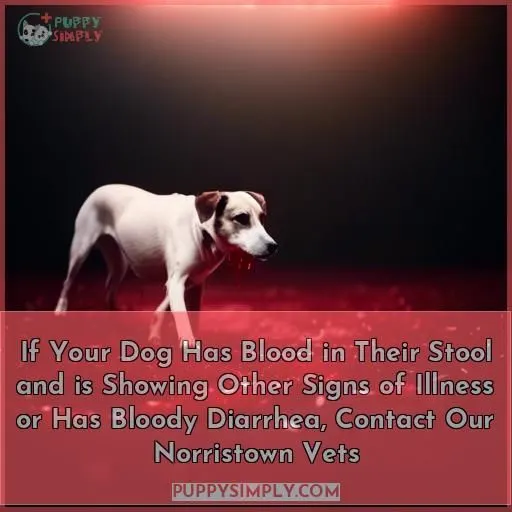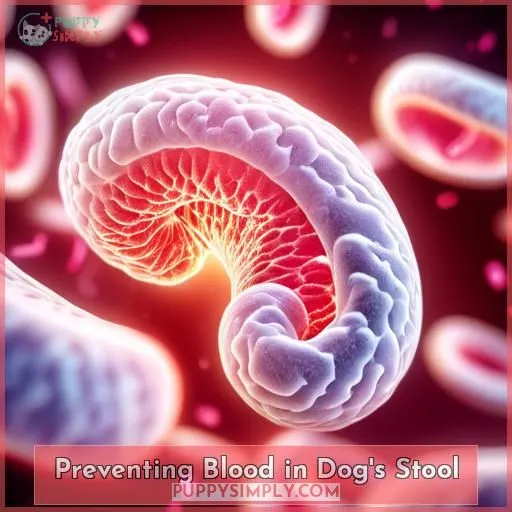This site is supported by our readers. We may earn a commission, at no cost to you, if you purchase through links.
 Discovering blood in your dog’s stool can be alarming. You’re their loving caretaker, so seeing this unsettling sight naturally raises concerns.
Discovering blood in your dog’s stool can be alarming. You’re their loving caretaker, so seeing this unsettling sight naturally raises concerns.
Don’t panic; many potential causes exist, ranging from dietary issues to illnesses needing medical attention. By understanding why your dog is pooping blood, you can promptly provide the appropriate care they need, ensuring their swift recovery and continued well-being.
Table Of Contents
- Key Takeaways
- Why is My Dog Pooping Blood ?
- Assess Your Dog’s Overall Health
- Assess Your Dog’s Stool
- Possible Causes of Blood in Stool
- If Your Dog Has Blood in Their Stool and is Showing Other Signs of Illness or Has Bloody Diarrhea, Contact Our Norristown Vets
- Treatment for Bloody Stool in Dogs
- Helping Your Dog Feel Better
- Preventing Blood in Dog’s Stool
- Frequently Asked Questions (FAQs)
- What is the difference between hematochezia and melena in dogs?
- How can I tell if my dog’s bloody stool is caused by a serious underlying condition?
- What should I do if my dog has been vomiting and has bloody stool?
- How can I prevent my dog from ingesting non-food items that may cause bloody stool?
- What home remedies can I use to help my dog feel better if they have bloody stool?
- Conclusion
Key Takeaways
- Assess your dog’s overall health, looking for signs of lethargy, vomiting, or aversion to food, which could indicate dehydration or internal bleeding.
- Examine your dog’s stool for consistency, mucus, and color, as these factors can provide clues about the underlying cause.
- Be aware of potential causes, such as parvovirus in puppies, severe food intolerance, inflammatory bowel disease, cancer, hemorrhagic gastroenteritis, ingestion of non-food items, intestinal blockages, or parasites.
- Seek veterinary attention promptly if you notice blood in your dog’s stool, as treatment may range from medications and electrolyte boosts to antibiotics or even surgery.
Why is My Dog Pooping Blood ?
Your dog may be pooping blood due to various reasons, including infections, parasites, or cancer that affects the digestive tract. If you notice blood in your dog’s stool, it’s essential to contact your veterinarian for advice, as it could be a sign of a serious health condition.
Assess Your Dog’s Overall Health
When your furry friend starts leaving behind a crime scene in the backyard, it’s time to play detective with their health.
First off, check if they’re acting more like a couch potato than their usual zoomy selves. Lethargy, coupled with a sudden aversion to food or a bout of vomiting, can be red flags.
These symptoms, especially when paired with bloody stools, might hint at dehydration or something more sinister like internal bleeding.
Before you rush off to the vet, gather any clues from their medical history that could shed light on the mystery.
A thorough physical examination by your vet can help pinpoint the culprit behind the bloody diarrhea.
Assess Your Dog’s Stool
Assessing your dog’s stool is crucial when you notice blood in their poop. The consistency, presence of mucus, and color of the stool can provide valuable clues about the underlying cause. If you find your dog’s stool is covered in mucus, it may indicate an intestinal inflammation or a dietary issue.
If you notice undigested food or foreign objects in the stool, it could be a sign of a gastrointestinal blockage. Abnormal color, such as bright red blood or black, tar-like stool, can indicate blood loss from the upper or lower digestive tract.
Dehydration is a serious concern if your dog is losing fluids through vomiting and bloody stool.
To assess your dog’s stool, take note of its consistency, mucus presence, and color. If you observe any of these signs, contact your veterinarian immediately. They may recommend blood tests, fecal exams, or imaging tests to identify the cause and determine the appropriate treatment.
In the meantime, ensure your dog is receiving a bland diet and plenty of fluids to help manage dehydration. If your dog is showing signs of seriousness, such as weakness, pale gums, vomiting, or refusing food and water, seek emergency care.
Possible Causes of Blood in Stool
If you see blood in your dog’s stool, it’s important to assess the situation and determine if your dog is showing any other signs of illness. The color and consistency of the blood can also provide clues about the underlying cause.
Causes of Blood in Stool
If you notice blood in your dog’s stool, it’s crucial to take immediate action. Here are some possible causes:
- Parvovirus in Puppies: This highly contagious virus is common in unvaccinated puppies and can be fatal if not treated promptly.
- Severe Food Intolerance: Some dogs may have adverse reactions to certain foods, leading to bloody stools.
- Inflammatory Bowel Disease (IBD): This condition can cause inflammation in the intestines, leading to symptoms like bloody stools.
- Cancer: Tumors in the intestinal tract can cause blood to appear in the stool.
- Hemorrhagic Gastroenteritis (HG): This condition can cause severe bloody diarrhea.
- Ingestion of Non-Food Items: Dogs may ingest items that irritate the digestive tract, leading to bloody stools.
- Intestinal Blockages: Foreign objects or tumors can obstruct the intestines, causing blood to appear in the stool.
- Parasites: Intestinal parasites can cause bloody stools.
If your dog is showing other signs of illness or has bloody diarrhea, contact your veterinarian immediately. They’ll assess your dog’s overall health and perform tests to identify the cause of the blood in the stool.
Treatment options may include medications for digestive tract upset, fluid therapy for dehydration, blood, urine, and fecal testing, and in severe cases, surgery.
Assessing Dog’s Health
If you notice blood in your dog’s stool, it’s crucial to assess their overall health. Start by observing their behavior and demeanor. If they appear normal, contact your regular veterinarian. However, if your dog seems unwell, with symptoms like vomiting, refusing to eat, or lethargy, visit an emergency vet immediately.
Blood in a dog’s stool can be caused by various factors, including dietary changes, ingestion of non-food items, infections, parasites, cancer, and inflammatory bowel disease. To assess your dog’s health, consider their age, breed, activity level, diet, recent medication, and any signs of inflammatory bowel disease or digestive tract upset.
If your dog is experiencing bloody diarrhea or vomiting, it’s a veterinary emergency. Loss of fluid through vomiting and bloody stool can lead to dehydration, which can be life-threatening.
To diagnose the cause of bloody stool in dogs, veterinarians may perform a detailed medical history, physical examination, blood tests, endoscopy, and X-rays. Treatment options include medications for digestive tract upset, fluid and electrolyte therapy, antibiotic therapy, and, in some cases, surgery.
To help your dog feel better, rest their intestines for 24 hours, feed a bland diet for a week, monitor for recurring symptoms, and consider introducing probiotics and prebiotics. If your dog is prone to inflammatory bowel disease, consider a hypoallergenic diet.
To prevent bloody stool in dogs, ensure they don’t ingest non-food items, maintain a balanced diet, and monitor for signs of infection or inflammation. Regular veterinary check-ups are essential for maintaining your dog’s overall health.
Treatment Options
After pinpointing the cause through diagnostic procedures, treatment may range from medications and electrolyte boosts to antibiotics or even surgery. Don’t fret; anthelmintics could also join the battle if parasites are the culprits.
If Your Dog Has Blood in Their Stool and is Showing Other Signs of Illness or Has Bloody Diarrhea, Contact Our Norristown Vets
If your dog is pooping blood and showing other signs of illness or has bloody diarrhea, it’s crucial to contact your veterinarian immediately. This could be a sign of an underlying disease, and delaying treatment could lead to dehydration risks.
When contacting your vet, provide a detailed medical history, including any recent dietary changes or ingestion of non-food items.
Here are some steps to follow:
- Contact Your Vet: Describe the type of blood observed in your dog’s stool, such as bright red (hematochezia) or dark, tar-like (melena).
- Provide a Detailed Medical History: Share any recent dietary changes, ingestion of non-food items, or exposure to toxins.
- Monitor for Other Symptoms: Look out for signs of dehydration, such as lethargy, pale gums, and loss of appetite.
- Seek Emergency Care if Necessary: If your dog is showing signs of a veterinary emergency, such as profuse bleeding from the anus, extreme lethargy, or collapse, bring them to the nearest emergency vet clinic right away.
Your vet may recommend a bland diet to help soothe your dog’s digestive tract and may prescribe medications to treat dehydration, inflammation, and pain. They may also perform blood, urine, and fecal testing to identify the cause of the bleeding.
In some cases, surgery may be necessary to remove obstructions or repair organ damage.
Treatment for Bloody Stool in Dogs
When it comes to treating bloody stool in dogs, there are several options available.
If your dog is experiencing this issue, it’s crucial to seek veterinary attention promptly.
The vet may recommend:
- Medications to soothe the intestines
- Electrolyte and fluid therapies
- Antibiotic therapy
- Surgical remedies
- Anthelmintics (dewormers)
A bland diet can also be beneficial, along with:
- Corticosteroid therapy
- A hypoallergenic medical diet
In some cases, an anal sac rupture may be the cause, which requires a different treatment approach.
It’s essential to follow the veterinarian’s advice and monitor your dog’s symptoms closely.
Helping Your Dog Feel Better
If your dog has been diagnosed with a cause of bloody stool, such as a dietary allergy or food intolerance, there are steps you can take to help your furry friend feel more comfortable.
First, consider introducing probiotic supplements to support their digestive health.
A hypoallergenic diet can also be beneficial, as it reduces the likelihood of adverse reactions to certain foods.
If your dog has experienced hemorrhoids or anal fissures, it’s essential to avoid irritating their sensitive area and provide them with a soft, comfortable bed.
In cases where your dog’s dietary needs are complex, it’s advisable to consult with a veterinary nutritionist to design a bespoke diet tailored to their specific needs.
Preventing Blood in Dog’s Stool
Preventing blood in your dog’s stool starts with a proactive approach.
First, consider diet changes. Introduce a hypoallergenic diet to minimize food intolerance, which can cause digestive issues.
Second, ensure your dog is protected against parasites. Regular deworming and flea treatments are crucial.
Third, cancer screening is essential, especially for older dogs. Regular check-ups can help detect early signs of cancer.
Lastly, maintain a clean environment to prevent your dog from ingesting non-food items.
Frequently Asked Questions (FAQs)
What is the difference between hematochezia and melena in dogs?
Hematochezia means bright red blood from the lower digestive tract. Melena is a dark, tar-like stool indicating bleeding from the upper GI tract.
How can I tell if my dog’s bloody stool is caused by a serious underlying condition?
Watch for lethargy, vomiting, pale gums, or lack of appetite. These signs indicate your pup needs urgent care for the bloody stool—it could signal a serious illness.
What should I do if my dog has been vomiting and has bloody stool?
Like a crimson warning light, vomiting and bloody stool scream emergency! Rush your furry friend to the vet – dehydration from those symptoms is no trifling matter.
How can I prevent my dog from ingesting non-food items that may cause bloody stool?
You’ll want to puppy-proof your home by keeping things off floors, using childproof latches, and closely supervising playtime.
What home remedies can I use to help my dog feel better if they have bloody stool?
With a gentle touch, soothe your pup’s tummy troubles: unsweetened pumpkin puree firms up loose stools; slippery elm bark coats and calms irritated guts.
Conclusion
As the adage goes, An ounce of prevention is worth a pound of cure. If your dog is pooping blood, don’t ignore it. Closely monitor their condition, note any additional symptoms, and consult your vet promptly.
With timely care and adherence to the recommended treatment plan, you’ll help your canine companion recover swiftly and prevent recurrences.













